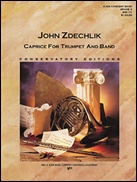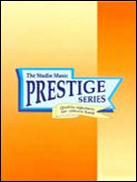Results
-
 £102.99
£102.99A Reunion in Love Wind Band Set (Score & Parts)
A beautiful ballad by the talented German composer Andreas Ludwig Schulte. In the romantic A Reunion in Love a leading role for the trombone player. Een prachtige ballade van de veelbelovende en getalenteerde Duitse componist Andreas Ludwig Schulte. In het romantische Reunion in Love is een hoofdrol weggelegd voor de trombonist(e). 04:45
Estimated dispatch 7-14 working days
-
 £45.54
£45.54Ancient Chinese Secret (Concert Band - Score and Parts)
This powerful work for young bands depicts vivid images of ancient Chinese warriors in battle. Many battles were won through strategically kept secrets that would surprise the enemy. Using only 4 pitches (Ab, Bb, Eb and E) this work will amaze your listeners with the technical complexity displayed by your young players. Perfect for your next festival or concert performance!
Estimated dispatch 7-14 working days
-
 £112.50
£112.50CAPRICE FOR TRUMPET AND BAND (Concert Band) - Zdechlik, John
Caprice for Trumpet and Band was written in 1994. It was commissioned by Robert E Foster, Conductor of the University of Kansas Symphonic Band. The premier performance was presented on March, 9 1995 in Lawrence, Kansas at the 61st annual conference of the American Bandmasters Association. The soloist was William Campbell, Professor of Trumpet at The University of Kansas. It was the intent of Robert Foster and the composer to produce a work which was challenging for a professional trumpet player yet also playable by an outstanding college student. The piece consist of two contrasting themes in the allegro section followed by a lyrical middle section. Then the first two themes return in altered fashion.Duration: 7:30 American Grade 5
Estimated dispatch 7-14 working days
-
 £154.99
£154.99Celtic Concertino Wind Band Set (Score & Parts) - Fraser, Bruce
This little concerto for clarinet was written for Peter Holligan , a friend of its composer, and the Fife Youth Concert Band (Scotland). The work was based on traditional Celtic music, and consists of three movements. 1. Reel - a fast dance ending in an atmospheric but virtuoso cadenza. 2. Lament - a slow and melancholy song hinting at the sound of bagpipes. 3. A fast and virtuoso dance in 6/8 time with Irish influence. The work is a wonderful audience-pleaser and an absolute 'must' for all clarinet-players. The band too is called upon and by all means does have its part to play in the piece. Band grade 4, soloist grade 5. Dit Concertino voor klarinet werd geschreven voor Peter Holligan , een vriend van de componist, en de Fife Youth Concert Band (Schotland). Het werk is gebaseerd op de traditionele Keltische muziek, en bestaat uit drie delen. 1. Reel - een snelle dans die eindigt in een sfeervolle, maar virtuoze cadens. 2. Lament - een trage en melancholische melodie die het geluid van doedelzakken verbeeldt.3. Een snelle en virtuoze dans in 6 / 8 maatsoort met Ierse invloeden. Voor het publiek een heerlijk werk om naar te luisteren en een uitdaging voor de solist(e)! Het orkest ondersteunt deze om het tot een kleurrijk geheel te maken! Orkest graad 4, solo graad 5. 10:00
Estimated dispatch 7-14 working days
-
 £134.99
£134.99Cos?' fan tutte Wind Band Set (Score & Parts)
In 1786 Mozart composed his wonderful opera Le Nozze di Figaro (KV 492). The Italian libretto, based on the play Le mariage de Figaro by Beaumarchais, was written by Lorenzo da Ponte--who also made the libretti of Mozart's opera's Don Giovanni and Cos? fan tutte. In the opera Le Nozze di Figaro, Count Almaviva tries to seduce the fianc?e of Figaro, his valet. Eventually, through four acts full of complicated intrigue, he is outwitted. In his music, Mozart--at times in a humorous way--reflects the numerous social and erotic intrigues with both empathy and insight. The brilliant overture is just as vivacious and witty as the opera itself. Mozart delightfully anticipates the passion and playful love that is to come. The skillful transcription for concert band by Tohru Takahashi certainly does justice to this appealing music.
Estimated dispatch 7-14 working days
-
 £69.99
£69.99Cowboy Suite Wind Band Set (Score & Parts)
In the tripartite 'Cowboy Suite' Alan Laken takes us to the Wild West, the domain of cowboys, indians, trappers and other fortune hunters. Around 1890 the west coast of America was reached, which in effect meant the end of the Wild West. Its stories, however, survived and have been a source of inspiration for many books, films, and, of course, music. Some characters, such as Jesse James, Billy the Kid, and Buffalo Bill are forever linked to these tales. In the 'Cowboy Suite' we first hear the 'Hoedown'. At the end of an exhausting workday the labourers used to lay down their tools, among others the 'hoes' and spontaneously began to play music on the instruments which they then possessed (guitars, fiddles, and banjos) and to dance. After being jolted on the 'Wagon Trail' we reach the third part, the 'Cowboy Roundup'. In this last part it becomes clear that as a cattle driver it is imperative to stay firmly seated in the saddle. As the cattle are rounded up, i.e. driven together, spectacular things happen. 04:45
Estimated dispatch 7-14 working days
-
 £149.95
£149.95Diversions - Variations on a Swiss Folk Song (Prestige Concert Band - Score and Parts) - Sparke, Philip
The variations are based on fragments of 'Der Heimetvogel', dating from the 19th century. The variations are: 1. Vivo e scherzando (a moto perpetuo); 2. Subito meno mosso (a macabre 12/8 march); 3. Lendo espressivo; 4. Vivace (fugue).Performance time 15'55"Recorded on QPRM134D THE KINGS GO FORTH, Central Band of the Royal Air Force
Estimated dispatch 7-14 working days
-
 £29.95
£29.95Diversions - Variations on a Swiss Folk Song (Prestige Concert Band - Score only) - Sparke, Philip
The variations are based on fragments of 'Der Heimetvogel', dating from the 19th century. The variations are: 1. Vivo e scherzando (a moto perpetuo); 2. Subito meno mosso (a macabre 12/8 march); 3. Lendo espressivo; 4. Vivace (fugue).Performance time 15'55"Recorded on QPRM134D THE KINGS GO FORTH, Central Band of the Royal Air Force
Estimated dispatch 7-14 working days
-
 £69.99
£69.99Fanitullen Wind Band Set (Score & Parts)
Fanitullen is a lively, beautiful 'Sl?tt', i.e. an old Norwegian melody which is played on a traditional 'Hardingfele' (Hardanger fiddle).Because of its violent rhythm and exciting character, playing a Fanitullen for a long time was considered improper. It was believed that a person playing this melody would come under the influence of the devil. Therefore, Fanitullen could be regarded as a kind of Rock'n Roll from the 18th century.Tom Brevik's adaptation is based on a composition for piano by Ole Olsen (1850-1927) 01:45
Estimated dispatch 7-14 working days
-
 £94.99
£94.99Farewell Song Wind Band Set (Score & Parts)
Farewell Song has been taken from Der Trompetervon S?ckingen by Victor E. Nessler (1841-1890). Thisopera tells the sentimental story of a plain musicianwho is eventually allowed to marry the daughter ofa baron. From the first performance in 1884, thisopera was well liked - not so much because of thestory but because of its musical features. Impressivetrumpet solos, drinking songs and dance scenes werethe ingredients that enthralled audiences throughoutEurope. Today, only the farewell song called JungWerner's Abschied, also known as Beh?t' dich Gott,has remained an absolute winner. Wil van der Beekhas written a fine arrangement of this entitledFarewell Song. He felt it was appropriate to entrustthe melody of this song, originally written for tenorvoice, to the baritone or euphonium. 0:05:15
Estimated dispatch 7-14 working days
